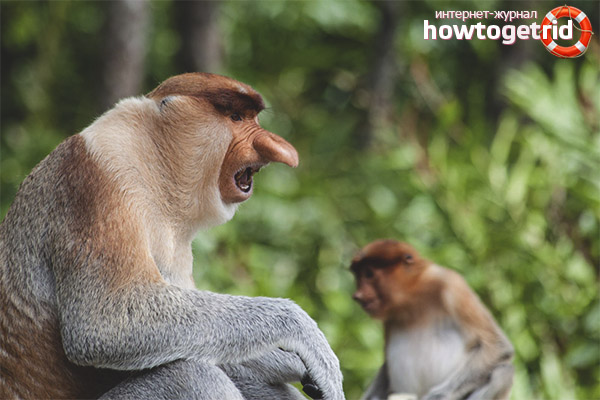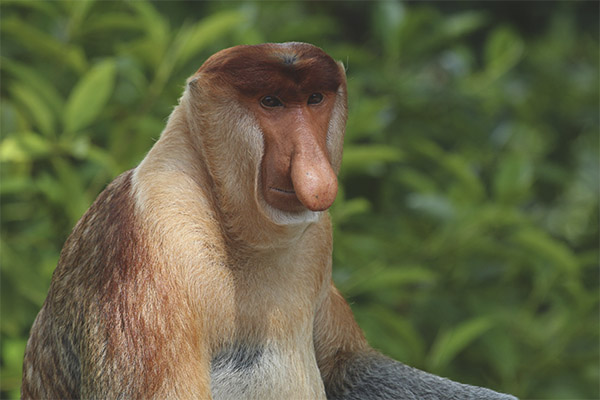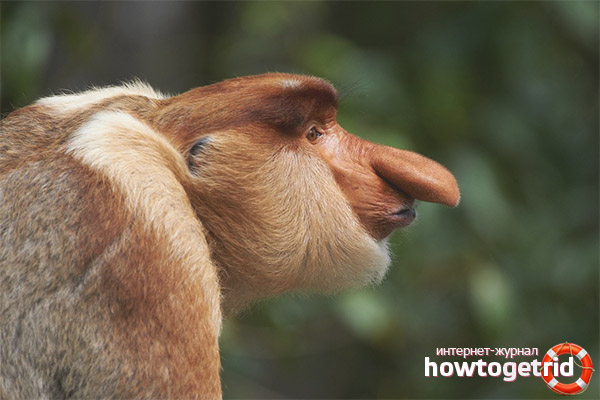The content of the article
The monkey nosach, or as it is more often called this species of primates, Kahau, has the most unusual appearance among its congeners. The name Kahau comes from the characteristic cry that the animal emits at the moment of danger. Nosach is one of the rarest species of primates now living on the earth.
Description of the species
A nosed monkey belongs to primates of medium size, depending on the sex, their weight does not exceed 20 kg, and the body length is no more than 78 cm. Thus, the average weight of females is 8-10 kg with a body length of 55-65 cm. In turn, the male weighs 15-20 kg, body length - 73-78 cm. As a rule, the tail, regardless of gender, is equal to body length.
The main feature of male primates is a large pear-shaped nose, lowered down, its size can be up to 10 cm in length. Sometimes this organ causes a lot of inconvenience while eating, and the monkey is forced to support it.In the study of the olfactory abilities of the nose and its purpose, the opinions of experts are divided.
Some argue that during quarrels with other primates, the growing red nose frightens the enemy.
According to others, thanks to the huge olfactory organ, the monkeys are able to shout louder, it is with a cry that the animal notifies of its presence in any territory, thus marking it.
Still others say that it is in the size of the nose that the female chooses the most mature male during the mating period.
The hanging nose is a characteristic feature of males only; in females and young primates, the smaller olfactory organ is upturned and raised, triangular in shape. The skin on the face is smooth without a coat, with pale red pigmentation. The back of a mature primate is covered with short hair. Its color can be dark, in brown-red or deep orange tones, or light, bright yellow or ocher. The belly coat has a light beige or pale gray color.
In addition to the nose, large abdomen and size, there are several external differences between males.Around the neck of the male hair grows much thicker, forming a kind of collar, and along the entire length of the spine there is a thick, dark mane. Regarding the body, the limbs appear lean and elongated, they are evenly covered with light gray wool. The primate's tail is strong and tenacious, however, it is practically not used, unlike muscular paws.
Lifestyle
At first glance, the nose makes an impression of a hulking bumpkin, but this is an erroneous opinion. The monkeys are very agile and easily move from tree to tree, they grab the branch with their front paws, swing and jump over, pulling up the hind limbs. They spend most of the day on the treetops, sometimes going down for water or a special delicacy. The greatest activity of the animal is observed in the afternoon. At night, hiding in the crowns of trees.
It is noteworthy that only this species of monkeys can dive, moreover, swim under water up to 20 meters. On the hind limbs, they have membranes that help monkeys swim on the surface of the water. From birth, the female teaches a baby to water procedures.
In addition, only 2 species of primates, including the nose, can easily move on the hind limbs, as a rule, they do it in dense forests, where it is difficult to pass on four legs.
Primates live in small groups of 10 to 30 individuals. Sometimes it includes only males or vice versa - females headed by a mature male, but more often they are mixed flocks. Nosachi are considered a good-natured species of monkeys, they can be aggressive only in defending their territory, conflicts in a flock happen extremely rarely. Between themselves, the communication of animals occurs with the help of unusual sounds or facial expressions.
Quarrels in mixed groups are almost excluded, in female flocks, though rarely. As soon as the conflict between the females matures, the leader abruptly stops him, emitting a nasal sound. There are cases when a younger and more belligerent male in the struggle for power expels the leader of the pack and destroys his offspring, in which case the mother of the killed cubs must also leave the group.
All attempts by zoologists to tame Kahau failed, this is due to their poor adaptation and low learning ability.Therefore, there is no information about the duration of their life in captivity. In the conditions of life in nature, the nose lives for about 20 years, as a rule, it depends on food and habitat.
Habitat
The coastal areas and lowlands of the Borneo Islands are habitats of noses monkeys. Peatlands, dipterocarp forests, wetlands with mangroves are preferred settlement zones for them. In addition, the monkeys do not rise in areas located above 250 m above sea level, the ideal place for them - the coastline along any reservoirs with fresh water.
Nutrition
The most common diet nosach monkeys are:
- only blooming leaves of trees;
- young shoots;
- flowers;
- unripe fruit.
In general, about 47 names of plants.
It is extremely rare for primates to eat the larvae of tree insects, beetles, and caterpillars. This squad of monkeys has a volumetric stomach in order to be filled, they sometimes have to walk several kilometers a day, returning to the place of settlement only late in the evening. They begin to look for food near the banks of the rivers and gradually move deep into the forest.
Nosach avoids plants that contain a natural antibiotic, and vice versa - can feed on those that are poisonous. This fact is explained by the fact that the Kahau stomach contains bacteria capable of neutralizing poisons, but they die by the action of antibiotics.
Enemies of a nosed monkey
Less commonly, monkeys become prey to large snakes, eagles or monitor lizards. Despite the protection of the Kahau population, they continue to be hunted by poachers because of valuable fur and meat. The clouded leopards living in Borneo prefer to hunt cattle and almost never attack monkeys.
Breeding species

Sexual maturity of male and female primates occurs at the age of 2-3 years.Despite the data of researchers that the male erection is constant, the mating period passes in the spring. The initiator of mating games is the female. She starts to flirt, shake her head, make grimaces, sticks out her lower lip or twists them with a straw, shows off her sexual organs.
After 200 days after mating, a baby appears, with a muzzle of a gray-blue color and the same snub nose as in the mother, from 3 months of age the color begins to change and resemble the color more like an adult. The weight of a newborn is about 500 g. Female nosacha is very caring mothers, they feed the baby up to 7 months and even after his growing up they support a relative relationship. When a male reaches the age of 1-2 years, he must leave the group. It is allowed to return to him only when he can compete with mature individuals. The female remains in the pack, grows up, and having reached puberty, continues to replenish the offspring, while she can move from one clan to another, live in it and mate.
Kahau population
Deforestation, drainage of swamps and the cultivation of areas that once served as a habitat for monkeys, lead to a sharp reduction in their numbers.The remaining territories, possible for settlement, are occupied by a more aggressive species of long-tailed macaques. Places of the Kahau specimen attract the burgeoning poachers fishing. Over the past 50 years, the number of nosed monkeys has decreased by half, to date, their population is about 3000 individuals. The species is listed in the International Red Book as endangered.
Video: monkey nosach (Nasalis larvatus)













To send